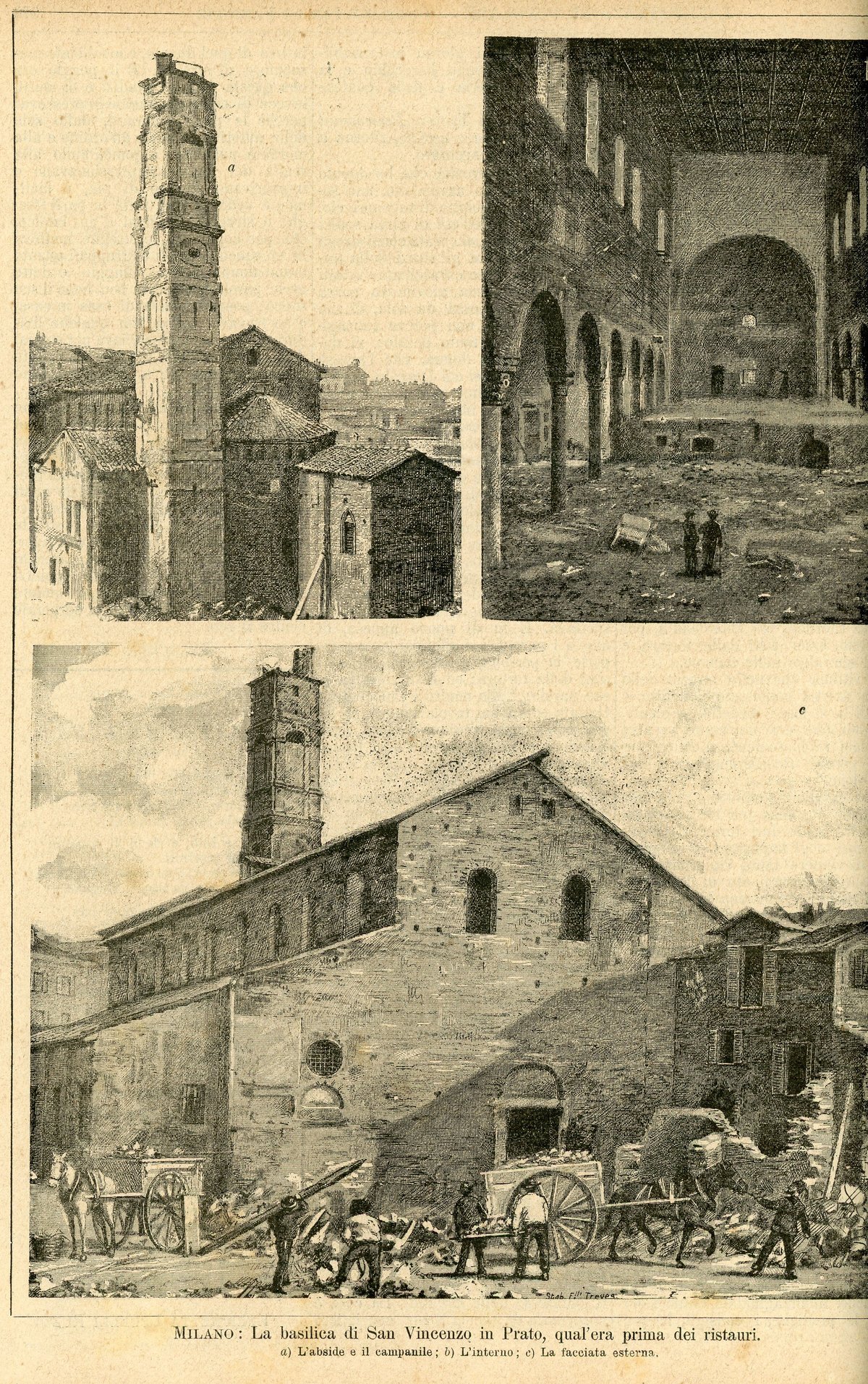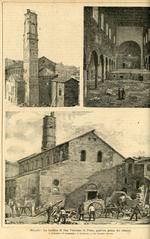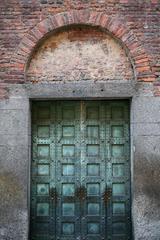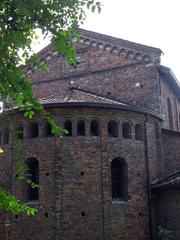
San Vincenzo in Prato Milan: Visiting Hours, Tickets, and Historical Sites Guide
Date: 14/06/2025
Introduction
San Vincenzo in Prato is one of Milan’s oldest and most significant churches, celebrated for its rare preservation of paleochristian architecture and profound spiritual heritage. Founded in 770 CE by Lombard king Desiderius atop a site with Roman origins, the basilica stands as a testament to Milan’s transformation from a Roman city to a medieval Christian center. The church’s unique historical trajectory, remarkable architectural features, and role as a living parish make it a must-visit for anyone interested in Milan’s cultural and religious landscape. This comprehensive guide details San Vincenzo in Prato’s visiting hours, ticketing, accessibility, and expert tips to help you make the most of your visit.
For further planning and up-to-date information, consult the official Milan tourism website and Lombardy Cultural Heritage portal.
Table of Contents
- Introduction
- Early Foundations and Roman Origins
- Lombard Era and Initial Construction
- Relics and Rededication
- Benedictine Monastery and Medieval Flourishing
- Renaissance, Decline, and Secularization
- 19th and 20th Century Restoration Efforts
- Architectural and Artistic Highlights
- Practical Visitor Information
- Enduring Significance and Community Role
- Frequently Asked Questions (FAQ)
- Conclusion and Call to Action
- References
Early Foundations and Roman Origins
San Vincenzo in Prato occupies a site steeped in ancient history. Archaeological evidence reveals that the church was constructed atop the remains of a Roman temple—likely dedicated to Jupiter—and a necropolis. Funerary stones and architectural fragments from this era are still visible in the church’s northern wall, emphasizing the continuity of sacred use from Roman times through the Christian era. Its position near ancient trade and pilgrimage routes underscores its longstanding significance within Milan’s urban fabric.
Lombard Era and Initial Construction
The first documented church on this site was established in 770 CE by King Desiderius, the last king of the Lombards. Originally dedicated to the Virgin Mary and known as Basilica Virginum, the church’s “in Prato” designation refers to its meadow location outside Milan’s Roman walls. The land belonged to Bishop Odelpertus, who granted it to the Monastery of Sant’Ambrogio in 806, reinforcing the church’s ecclesiastical importance.
Relics and Rededication
In the 9th century, the discovery of relics attributed to Saint Vincent, Saint Quirinus, and Saint Nicomedes in the crypt prompted a rededication of the church. Its consecration in 859 CE marked it as an important pilgrimage destination. The crypt, one of Milan’s only original Romanesque crypts, contains ancient sarcophagi and relics that continue to attract pilgrims and visitors.
Benedictine Monastery and Medieval Flourishing
A Benedictine monastery was established adjacent to the church in 806, enhancing its spiritual and social influence. The monastic community maintained and expanded the church, carefully preserving its early Christian layout through subsequent reconstructions in the 9th to 11th centuries. During the Middle Ages, San Vincenzo in Prato flourished as a spiritual and community hub, preceding the rise of other major Milanese basilicas.
Renaissance, Decline, and Secularization
San Vincenzo in Prato’s fortunes waned in the early modern era. The Benedictine monastery was suppressed in 1520, and the church became a parish in 1598. Its most turbulent period came during the Napoleonic occupation, when it was deconsecrated and used for secular purposes, including as a warehouse and a laboratory, resulting in damage and loss of significant frescoes. Despite these challenges, the church’s core architectural character remained largely intact.
19th and 20th Century Restoration Efforts
Renewed interest in the church’s historical value led to major restoration campaigns in the late 19th and 20th centuries. Efforts focused on reviving the paleochristian character, with interventions by architects Vito and Gustavo Latis restoring the flooring, roof, and crypt. Stained glass windows by Marta Latis and the removal of 19th-century decorative additions further honored the church’s early Christian heritage.
Architectural and Artistic Highlights
San Vincenzo in Prato is a rare Milanese church that has preserved its original basilica layout. Notable features include:
- Exterior Structure: The simple, exposed brick façade with three arched portals reflects early Christian austerity. Fragments of Roman funerary monuments are embedded in the north wall (Lombardia Beni Culturali).
- Nave and Columns: The three naves are separated by columns, many of which are Roman spolia, each with unique capitals.
- Crypt: A major highlight, accessible beneath the presbytery, containing ancient sarcophagi and relics.
- Artworks: The “Madonna del pianto” fresco and other medieval fragments, as well as a marble altar and sculpted capitals.
- Baptistery: The octagonal baptistery (1932) houses a historic baptismal font from San Nazaro in Pietrasanta.
Natural light from single-arched windows fills the interior, emphasizing the serene and contemplative atmosphere.
Practical Visitor Information
Location and Access
- Address: Via Daniele Crespi 6, Milan, in the Ticinese/Porta Genova district.
- Public Transport: Metro M2 (Porta Genova), tram lines 2 and 9, bus lines 59 and 61 (ATM Milano).
Visiting Hours
- Typical Hours: Tuesday to Sunday, 9:00 AM to 6:00 PM.
- Closed: Mondays and major public holidays. Check the official parish website for updates and special openings.
Tickets and Admission
- General Admission: Free.
- Donations: Welcomed to support maintenance and restoration.
- Guided Tours: Available during cultural events or by prior arrangement; booking recommended via the official Milan tourism website.
Accessibility
- Main Nave: Wheelchair accessible via ramp.
- Crypt: Limited accessibility due to stairs and uneven flooring.
Visitor Tips
- Dress Code: Modest attire (shoulders and knees covered).
- Best Times: Weekday mornings offer a quieter experience.
- Facilities: No restrooms inside; nearby cafés and restaurants available.
- Photography: Allowed without flash or tripods; be respectful during services.
Nearby Attractions
- Basilica di Sant’Eustorgio: Relics of the Magi and medieval frescoes.
- Navigli Canals: Vibrant area with dining and art studios.
- Porta Ticinese: Historic city gate and lively neighborhood.
Enduring Significance and Community Role
San Vincenzo in Prato is not only a monument to Milan’s layered history but also an active parish and cultural hub. Its integration into local religious and cultural life, participation in Milanese traditions such as the Ambrosian Rite, and involvement in events promoting interfaith dialogue and heritage preservation underscore its ongoing relevance. The church’s inclusion in educational programs and heritage itineraries fosters appreciation of Milan’s early Christian roots (Milan Tourism).
Frequently Asked Questions (FAQ)
Q: What are the visiting hours for San Vincenzo in Prato?
A: Typically Tuesday–Sunday, 9:00 AM–6:00 PM; closed on Mondays and major holidays. Confirm on the official website.
Q: Is there an entrance fee?
A: Admission is free; donations are appreciated.
Q: Is the church accessible for visitors with disabilities?
A: The main nave is accessible by ramp, but the crypt has limited access.
Q: Are guided tours available?
A: Yes, especially during cultural events or by prior arrangement. Check the Milan tourism website.
Q: Can I take photos inside?
A: Yes, non-flash photography is allowed; respect the sacred atmosphere.
Q: How do I reach San Vincenzo in Prato by public transport?
A: Nearest metro: Porta Genova (M2); also served by tram and bus lines.
Conclusion and Call to Action
San Vincenzo in Prato offers a compelling journey through Milan’s ancient and medieval Christian heritage, standing as a unique survivor of Lombard and early Christian architecture. With free admission, accessible visiting hours, and guided tours, it is an essential stop for anyone exploring Milan’s historical sites.
Plan your visit today: Check official sources for up-to-date information on visiting hours and tickets. Enhance your experience by downloading the Audiala app for guided audio tours, and explore our related posts on Milan’s architectural and spiritual landmarks. Stay connected through social media for the latest updates and inspiration for your next cultural adventure in Milan.
References
- San Vincenzo in Prato Visiting Hours, Tickets, and Milan Historical Sites Guide, 2025
- San Vincenzo in Prato: Visiting Hours, Tickets, and Architectural Highlights in Milan, 2025
- San Vincenzo in Prato: Visiting Hours, Tickets, and Exploring Milan’s Historic Christian Site, 2025
- San Vincenzo in Prato: Visiting Hours, Tickets, and Exploring Milan’s Historic Church, 2025






























































